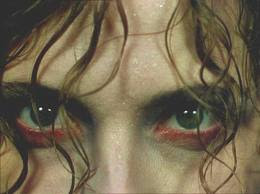 |
| Deborah Kerr as Sister Clodagh. |
Five Anglican nuns arrive at an isolated palace, perched nine thousand feet up in the Himalayas, to establish a convent with a school and hospital. They are led by Sister Clodagh (Deborah Kerr), the youngest Sister Superior in the order. Once the site of a maharajah's harem, there is something seductive about the location, leading one character to say it "makes everything exaggerated." The winds are constant, the air is crystal clear and thick with the scent of intoxicating flowers, there are fantastic colors, and Mr. Dean (David Farrar), the British agent. He's the only white man in the area and keeps them supplied, and acts as an interpreter of sorts with the local population.
Weighed down by responsibility, and going up against native suspicions, Sister Clodagh's mind begins to wander in the exotic surroundings. In her reverie, she thinks back to her life in Ireland before she decided to pursue a religious life. Shown in flashback, we see she was in love and leading a full life. It's only time we see Kerr's glorious auburn hair. As she begins to doubt her commitment to God, one wonders if her decision to enter the order was a wise one. Is she trying to escape a lost love? All the nuns experience some kind of malaise, one rips up the vegetable garden to plant more flowers, but it is Sister Ruth (Kathleen Byron), the youngest, who faces a crisis. Perhaps unhinged before they even arrive—Clodagh tried to dissuade the Mother Superior from including Ruth in the group—Sister Ruth becomes obsessed with Mr. Dean, convinced she is in love. She becomes unglued and increasingly jealous of Sister Clodagh, whom she believes has her own designs on the man.
The British director/writer team of Powell and Pressburger had already produced several highly successful films. But in theme, this was their most ambitious. Previous work dealt with patriotism and secular love. Black Narcissus is infused with religious overtones, leaving the audience to ponder how ordinary human beings can expect to eschew normal temptations to pursue a godly commitment. Do they ever, entirely? Does it make sense to impose a formal, man-made religious institution in a place and setting with its own spirituality and values?
An interesting aspect of the film is the relationship between Sister Clodagh and Mr. Dean. His reactions in a few scenes give you the impression he may have developed something beyond mere respect for the woman: innuendos that may not be so innocent, the way he holds a look or takes her hand. After-all, she is beautiful, even in a habit, and intelligent and obviously compassionate. But his affection is uncertain; he never verbally expresses anything to her that one could take as proof. For her part, it is even more ambiguous, but Kerr's character is made of stern stuff. In one famous scene the shadow of a cross flashes across her face, hinting at her ultimate choice.
Kathleen Bryon gives a chilling performance as the mentally disturbed nun. The directors have built suspense by showing her slow dissolve into psychosis and they create a wonderfully moody scene for her final appearance. She appears with blood red lipstick and a crazed stare, having renounced her vows. Dramatic music and a shadowy, wet, and windy convent courtyard give it a Gothic horror atmosphere. At this point, Mr. Dean has spurned her advances and she focuses her rage on Sister Clodagh. It leads to an exciting confrontation at the bell tower, high above the verdant jungle below.
 |
| Sister Ruth becomes unhinged. |
The film is a spectacular technical achievement. Alfred Junge created much of the Himalayan scenery in the studio using glass shots and hanging miniatures. And the backdrops were blown-up black and white photographs layered with pastel chalks. Like all Powell /Pressburger films it is beautiful to look at. Cinematographer Jack Cardiff's made the colors pop to enhance the exotic feel of the story. He'd win an Oscar for the film.
Jean Simmons plays an Indian girl of low caste, described in the source novel as a "basket of fruit, piled high and luscious and ready to eat." She has infatuated an Indian prince and serves in sharp contrast to the nuns as their alter-ego. Sister Ruth aspires to her sexual freedom.
What Makes Narcissus Special:
The color scheme and costumes are fantastic, with clearly separate motifs designed for each class of character. Nuns always appear in white habits of a medieval type. The chief native characters (the old king and his son) wear brilliantly colored robes, decorated in jewels and rich silks. Other locals are clad in more somber colors, with the usual native dress of the Nepalese, Bhutanese and Tibetan peoples toned down to prevent overloading the eye with brilliance.
 |
| Kathleen Byron as Sister Ruth. |
Inside Story:
Michael Powell's thought this his most erotic film, saying, "It is all done by suggestion, but eroticism is in every frame and image from beginning to end. It is a film full of wonderful performances and passion just below the surface, which finally, at the end of the film, erupts."
The New York Times described the film as "a curiously fascinating psychological study of the physical and spiritual tribulations that overwhelm" the five nuns.
Major Awards:
Won Oscars for Best Art Direction-Set Direction (Alfred Junge) and Best Cinematography (Jack Cardiff). Kerr won Best Actress from the New York Film Critics. And the BFI named it as the 44rd greatest British film.
Other Films of Interest by P&P:
- The Invaders (AKA: 49th Parallel) 1941
- The Life and Death of Colonel Blimp 1943
- I Know Where I'm Going 1945
- A Matter of Life and Death 1946
- The Red Shoes 1948

No comments:
Post a Comment